There are several species of Schlumbergera but the ones that most people know of is the Christmas Cactus. In fact that name is commonly used to wrongly describe other species of Schlumbergera.
One Schlumbergera that is commonly mistaken is the Thanks Giving Cactus also known as the False Christmas Cactus and properly defined as Schlumbergera truncata.
There is a very strong resemblance between both the Christmas and Thanks Giving Cactus and the easiest way to determine which is which is to look at the leaves on your plant. The Thanks Giving cactus has sharply serrated or “toothed” leaves, whereas the Christmas cactus has smooth sided more rounded leaves.
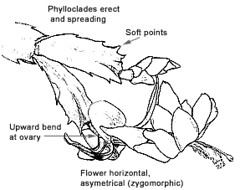
Thanks Giving Cactus leaves
|
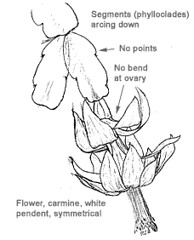
Christmas Cactus Leaves
|
Another strong difference between the two plants is that the Thanks Giving Cactus begins to develop buds near the beginning of November and is often in full bloom by the time that the American Thanks Giving takes place. Christmas cactus bloom around Christmas time and often into January and February.
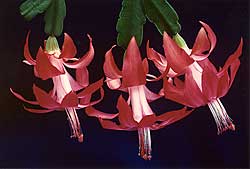 Actually both the Thanksgiving Cactus and Christmas Cactus are known to bloom twice a year, with the first blooms of the Thanks Giving cactus between October and November and the second between February and March, while the Christmas Cactus tends to bloom in December and January, and then again in April or May.
Actually both the Thanksgiving Cactus and Christmas Cactus are known to bloom twice a year, with the first blooms of the Thanks Giving cactus between October and November and the second between February and March, while the Christmas Cactus tends to bloom in December and January, and then again in April or May.
The other species of Schlumbergera that I referred to earlier is the least common of the three. It is the Easter Cactus. Schlumbergera gaertneri only blooms once a year in April – usually near Easter, hence the name. Its flower is very different.
It is not nearly as popular as the Thanks Giving and Christmas Cactus’ because it is rather more difficult to grow well, and it has the disconcerting habit of shedding its stem segments at the slightest drought, or whenever over- or under-watered. It may refuse to bloom for no apparent reason.
Enthusiasts tend to lose patience with this one, which is a pity, because it is quite magnificent in spite of all that.
The tips of the leaf segments on the Easter Cactus have soft bristles making it very easy to distinguish from the other two common species of Schlumbergera.
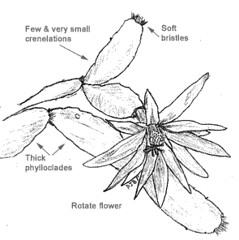
Easter Cactus leaves
|
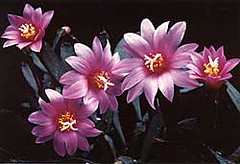
Rose Easter Cactus Flowers
|
Thanksgiving cactus is a winter-flowering houseplant native to Brazil, which comes in a wide array of colors including red, purple, oranges, pinks and whites although reds, whites and pinks are the most common. When planted in a decorative pot, Thanksgiving cacti make a wonderful holiday table centerpiece, or as a gift for friends and family.
Thanksgiving cactus grows well in light shaded areas. They prefer an evenly moist soil although they can tolerate dry conditions. So, do not allow the soil become waterlogged, especially during the dark days of winter. Do not let the soil dry out either. Reduce watering from fall through spring. Fertilize plants monthly from the time new growth starts in late winter or early spring, and throughout the summer using a one-quarter strength soluble fertilizer. Reduce fertilizer during the fall and early winter. The Thanksgiving cactus flowers best when kept somewhat potbound. Repotting is necessary only about once in three years. The potting media must be well-drained with good aeration, because the plant does not grow well in heavy, wet mixes. A good mix may contain one part potting soil, two parts peat moss and one part sharp sand or perlite.
They do not tolerate frost and hence they need special care during the frosting months when they should be brought indoors. For these cacti to form buds, during mid-September, these cacti will need 12 to 14 hours of total darkness along with cool nighttime temperatures. The easiest way to achieve this is to place the plant in a closet from dusk to dawn. Or you can cover it with a large brown paper bag. If you keep the plant in a cool room (around 50 degrees F 24 hours a day) in September and October, chances are excellent that it will produce flowers, regardless of day length.
In the last two years, since Toronto doesn’t get very cool until November I’ve often continued to keep my Thanks Giving Cactus and Christmas cactus outdoors (they spend the summer outdoors in fairly sunny spots- but not full sun) until at least mid-October. At that time I bring each of the plants into my cool basement. I tend to bring the Thanks giving cactus back upstairs at the beginning of November and the Christmas Cactus back to the main floor in Mid November. In this way they get the cooling and a period of very low light that they need in order to jolt them into blooming machines.
Happy Thanks Giving to my American visitors!
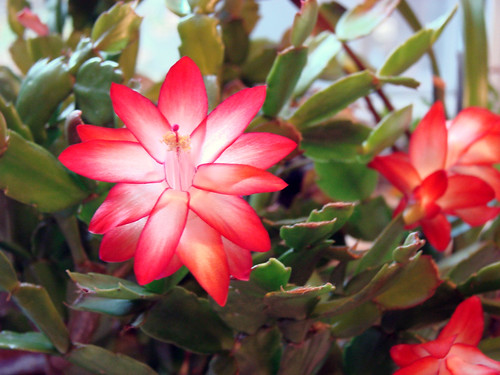
Just visiting via the Canadian Blogroll!
That is a pretty picture of the cactus. Mine never look like that!
Thank you for the clear explanation and photos of the leaf differences, Tricia. I bought three plants a week ago to use for the dining table. They were in bud with a few open blooms, and sure enough – their leaves are toothed rather than rounded, with the bend where they are attached.
Annie at the Transplantable Rose